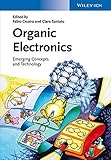Organic electronics : emerging concepts and technologies / edited by Fabio Cicoira and Clara Santato.
Contributor(s): Cicoira, F. (Fabio) | Santato, Clara.
Material type: BookPublisher: Weinheim, Germany : Wiley-VCH, ©2013Description: 1 online resource (xviii, 443 pages) : illustrations.Content type: text Media type: computer Carrier type: online resourceISBN: 9783527650996; 3527650997; 3527411313; 9783527411313; 9781299738096; 1299738095.Subject(s): Electronics -- Materials | Organic electronics | Printed circuits | TECHNOLOGY & ENGINEERING -- Mechanical | Electronics -- Materials | Organic electronics | Printed circuitsGenre/Form: Electronic books. | Electronic books.Additional physical formats: Print version:: Organic Electronics : Emerging Concepts and Technologies.DDC classification: 621.381 Online resources: Wiley Online Library
BookPublisher: Weinheim, Germany : Wiley-VCH, ©2013Description: 1 online resource (xviii, 443 pages) : illustrations.Content type: text Media type: computer Carrier type: online resourceISBN: 9783527650996; 3527650997; 3527411313; 9783527411313; 9781299738096; 1299738095.Subject(s): Electronics -- Materials | Organic electronics | Printed circuits | TECHNOLOGY & ENGINEERING -- Mechanical | Electronics -- Materials | Organic electronics | Printed circuitsGenre/Form: Electronic books. | Electronic books.Additional physical formats: Print version:: Organic Electronics : Emerging Concepts and Technologies.DDC classification: 621.381 Online resources: Wiley Online Library Includes bibliographical references at the end of each chapters and index.
Online resource; title from PDF title page (Wiley, viewed September 16, 2013).
Organic Electronics: Emerging Concepts and Technology; Contents; Preface; List of Contributors; 1 Nanoparticles Based on p-Conjugated Polymers and Oligomers for Optoelectronic, Imaging, and Sensing Applications: The Illustrative Example of Fluorene-Based Polymers and Oligomers; 1.1 Introduction; 1.2 Nanoparticles Based on Fluorene Polymers; 1.2.1 Optoelectronic Applications; 1.2.1.1 Characterization of Nanoparticles; 1.2.1.2 Nanoparticle Film Fabrication and Characterization; 1.2.1.3 OLEDs; 1.2.1.4 Solar Cell Applications; 1.2.2 Imaging and Sensing Applications.
1.2.2.1 Characterization of Nanoparticles1.2.2.2 Biosensing; 1.2.2.3 Bioimaging; 1.3 Nanoparticles Based on Fluorene Oligomer; 1.3.1 Characterization; 1.3.2 Nanoparticles for Sensing and Imaging; 1.4 Conclusions and Perspectives; References; 2 Conducting Polymers to Control and Monitor Cells; 2.1 Introduction; 2.2 Conducting Polymers for Biological Applications; 2.2.1 Unique Benefits of Conducting Polymers; 2.2.2 Biocompatibility of Conducting Polymers; 2.2.3 Electrochemical Properties and Tools; 2.3 Conducting Polymers to Control Cells.
2.3.1 Establishing Conducting Polymers as Cell Culture Environments2.3.2 Optimizing Conducting Polymers for Cell Culture; 2.3.3 Controlling Cell Adhesion via Redox State; 2.3.3.1 Redox Switches; 2.3.3.2 Redox Gradients; 2.3.3.3 Protein Characterization as a Function of Redox State; 2.3.4 Direct Patterning of Proteins to Control Cell Adhesion; 2.3.5 Controlling Cell Growth and Development; 2.3.5.1 Electrical Stimulation to Promote Neurite Formation and Extension; 2.3.5.2 Electrical Stimulation to Promote Muscle Cell Proliferation and Differentiation.
2.3.5.3 Alignment Control via Topographical Cues2.3.5.4 Incorporation of Biomolecules to Control Differentiation; 2.3.6 Organic Electronic Ion Pumps; 2.3.7 On-Demand Cell Release; 2.3.8 Conducting Polymer Actuators; 2.3.9 Optoelectronic Control of Cell Behavior; 2.4 Conducting Polymers to Monitor Cells; 2.4.1 Conducting Polymers to Monitor Neuronal Function; 2.4.1.1 Conducting Polymer Electrodes; 2.4.1.2 Transistors; 2.4.2 Conducting Polymers to Monitor Behavior of Nonelectrically Active Cells; 2.5 Conclusions; References; 3 Medical Applications of Organic Bioelectronics; 3.1 Introduction.
3.2 Regenerative Medicine and Biomedical Devices3.2.1 Scaffolds, Signaling Interfaces, and Surfaces for Novel Biomedical Applications; 3.2.1.1 Scaffolds and Surface Modulation; 3.2.1.2 Biomolecule Presenting Surfaces; 3.2.1.3 Degradable Surfaces for Biomedical Applications; 3.2.1.4 Controlled Substance Release; 3.2.2 Prosthetics and Medical Devices; 3.2.2.1 Organic Bioelectronics as Actuators; 3.2.2.2 Neuroprosthetics; 3.3 Organic Electronics in Biomolecular Sensing and Diagnostic Applications; 3.3.1 Organic Electronics as Biomolecule Sensors: A Technological Overview.
An overview of the tremendous potential of organic electronics, concentrating on those emerging topics and technologies that will form the focus of research over the next five to ten years. The young and energetic team of editors with an excellent research track record has brought together internationally renowned authors to review up-and-coming topics, some for the first time, such as organic spintronics, iontronics, light emitting transistors, organic sensors and advanced structural analysis. As a result, this book serves the needs of experienced researchers in organic electronics, graduate.



There are no comments for this item.